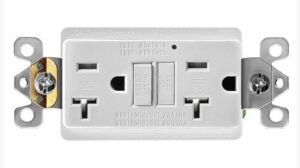Introduction
If you work in the HVAC industry, you already know that electrical safety is a top priority. Whether you’re installing HVAC systems in residential homes or commercial buildings, protecting both people and equipment from electrical hazards is crucial. That’s where GFCI (Ground Fault Circuit Interrupter) outlets come in.
In this article, we’ll break down what a GFCI outlet is, why it’s necessary, and how it helps ensure safety and compliance with regulations.

1. What is a GFCI Outlet?
A GFCI outlet is a special type of electrical outlet designed to protect against electrical shocks and prevent fires caused by ground faults.
How does it work?
- A GFCI continuously monitors the flow of electricity in a circuit.
- If it detects even a small leakage of current (as little as 4-6 milliamps), it shuts off power within 0.025 seconds—fast enough to prevent a dangerous shock.
Think of a GFCI like a security guard. The moment it senses something wrong, it immediately cuts off power, keeping people and equipment safe.

2. Why is Installing a GFCI Outlet So Important?
Electrical shocks and fires are real dangers in HVAC installations. The National Electrical Code (NEC) requires GFCI protection in many areas, especially where moisture is present.
Here’s why GFCIs matter:
✔ Protects Lives: Prevents electric shocks in areas prone to moisture, like kitchens, bathrooms, garages, and outdoor spaces.
✔ Reduces Fire Risk: Stops electrical leakage that could cause fires.
✔ Prevents Equipment Damage: Keeps HVAC units and electrical components from malfunctioning due to ground faults.
✔ Ensures Compliance: NEC and OSHA regulations require GFCIs in high-risk areas—installing them helps avoid fines and liability issues.
Where Should You Install a GFCI?
- Residential: Kitchens, bathrooms, basements, outdoor outlets, and garages.
- Commercial & Industrial: Restaurants, schools, hospitals, factories, and construction sites.
3. GFCI vs. Standard Outlets: What’s the Difference?
| Feature | Standard Outlet | GFCI Outlet |
|---|---|---|
| Main Function | Supplies electricity | Supplies electricity & protects against shocks |
| Shock Protection | ❌ No | ✅ Yes |
| Fire Prevention | ❌ No | ✅ Yes |
| Required by Code? | ❌ No | ✅ Yes (for high-risk areas) |
| Best For | Dry indoor spaces (bedrooms, offices) | Wet or high-risk areas (kitchens, bathrooms, garages) |
A GFCI outlet is a must-have in any electrical system where water or moisture is present. Standard outlets cannot provide this level of protection.
4. Key Benefits of GFCI Outlets
💡 Safety First: Protects people from life-threatening shocks.
💡 Prevents Costly Damages: Avoids damage to HVAC systems and other electrical appliances.
💡 Regulatory Compliance: Meets NEC and OSHA requirements.
💡 Peace of Mind: Ensures a safer electrical system for homes and businesses.
5. Conclusion: Why You Need GFCI Outlets
GFCI outlets are not just an option—they are a necessity for electrical safety in HVAC installations. Whether you’re a wholesaler, distributor, or installer, recommending and using GFCIs is a smart move.
Want to learn how to install GFCI outlets efficiently and cost-effectively?
👉 Check out our next article on GFCI installation and maintenance!

